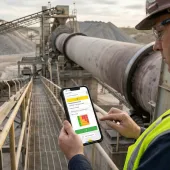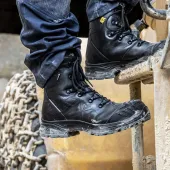Health authority
Falls from height are the most common cause of workplace fatalities in the UK. In this issue, MQR colomnist and former Hanson H&S expert Colin Nottage offers guidance on how to reduce incidents each year in his second ToolBoxTalk focused Health Authority column.
Falls from height are by far the most common cause of workplace deaths and one of the main causes of major injury in the workplace – 13% of all extraction and utilities major injuries, according to the latest Health and Safety Executive (HSE) figures for 2006-07.
These same figures also reveal further insightful statistics. Across UK industry 45 people died after falling from height during the period, while 3,409 employees suffered serious injury and 3,922 fell victim to over three-day injuries.
Falls from height incident numbers are dropping but as the HSE’s own report states, these published figures do not reflect the true story. The HSE estimates the reporting level for H&S incidents across the UK sits at a lowly 54%. For the self-employed it is less than 10%. The true impact falls from height are having on the UK economy is doubtless much greater than offical figures suggest.
The cause of a third of falls is ladders. However, workers are at risk when on stepladders, goods vehicles (while loading/unloading), tankers (while filling), machinery, open edges, roofs, mobile elevated work platforms, and waste containers.
In terms of a working definition, the HSE states work at height is “...work in any place – from which, if no action was taken, a person could fall a distance, liable to cause personal injury”. This could be above or below ground level.
The HSE has focused heavily on working at height for a number of years now and revised legislation came out in 2005.
Within the guidance is a ‘hierarchy of control’ (a league table of controls) that has been introduced to help employers deal with working at height. It follows three basic principals:
- Where possible working at height should be avoided.
- Use work equipment or other measures (MEWP, cherry picker, scaffolding, etc) to prevent falls where work at height cannot be avoided.
- Where the risk of a fall cannot be eliminated, use work equipment or other measures (fall restraint and fall arrest equipment, nets, etc) to minimise the distance and severity of a fall should one occur.
I have investigated a number of incidents where people have fallen from height. It is often the case that the ‘hole’ they fell through was not there when the job started but appeared as plant and equipment was moved or removed from the work location.
So when planning a schedule of work it is vital that site managers ensure the following:
- A working at height risk assessment is undertaken.
- Work at height is properly planned, supervised and controlled.
- Equipment used for work at height is properly inspected and maintained in accordance with manufacturer’s instructions.
- Suitable warning notices are posted.
- Appropriate safety equipment is used.
- All fragile surfaces are clearly marked at ground level.
- People working at height are trained, competent and authorised to undertake the work.
And when undertaking a risk assessment it is important to ensure the following:
- It is undertaken by a competent person.
- You consider the ‘hierarchy of controls’ and ensure that the most appropriate method of working is selected, and that a record of it is made.
- You consider non-workers, the public and others as a priority.
- The place of work, including access and egress, is safe.
- The controls continue for the duration of the work as maintenance activities often create unforeseen at height risks.
- You take account of weather conditions that may endanger health and safety, such as high winds, lightning, heavy rain, etc.
- Risks from fragile surfaces are properly controlled and risks from falling objects are minimised.
- You plan for emergencies and rescue.
- You consider ground conditions that may affect plant and equipment.
Remember to involve the people who are completing the task when you undertake an assessment, and explain the outcome of the risk assessment to them.
When it comes to ladders, remember they are not work platforms. They are used for access and egress. If all other means of safe access have been exhausted and a risk assessment has deemed it acceptable then simple ladder work may be undertaken. However, when using a ladder it should be:
- Prevented from slipping.
- Prevented from moving before it is stepped on.
- Long enough to do the job safely
- Have a handhold available to allow the worker to maintain three points of contact where possible
- Used without overreaching
- Inspected and checked regularly where necessary.
Working at height is regularly undertaken and it can be completed safely if you plan the activity and maintain the controls.








